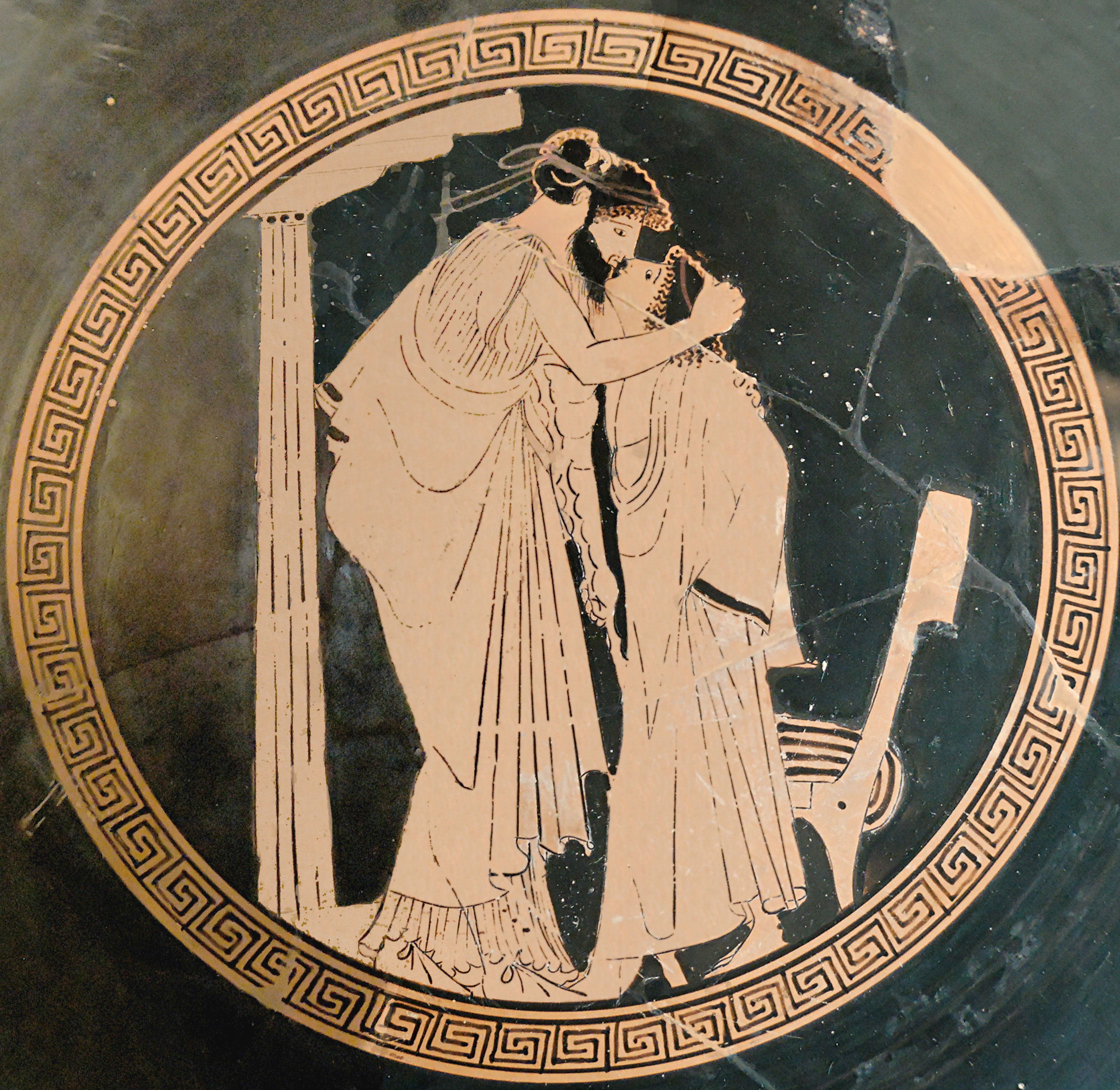Known for their adventurous and seemingly unconventional attitudes to love, sex and gender, the Ancient Greeks have long appealed to our most basic instincts, satisfying our curiosity with lurid tales. Though widely remembered for their practice of homosexuality, their legacy today is definitely much more than that of a sex-mad civilisation, with depraved practices to make any reader with 21st century sensibilities cringe.
Paul Chrystal, author of new book In Bed With the Ancient Greeks (out now from Amberley), shines a light on sex and sexuality in the ancient world. It’s pretty NSFW, this is your final warning.
The Ancient Greeks are known for having a more nuanced view of ‘love,’ with different words for different types, such as eros, storge, and agape. What do you think this says about the Greeks – and about our own society for relying on just one word?
Ancient Greeks were patently much more philosophically and psychologically nuanced than their contemporary counterparts to the north and west. While the Pre-Socratics (6th and 5th centuries) and their successors were exercised by the very meaning of life – and love – the Celts, for example, were consumed by matters much less cerebral.
For most ‘barbarians’, society was far less developed or sophisticated so one word (love) fits all while the Greeks, not least with Plato (427 bce – 347),and Aristotle (384 BCE – 322), needed a lexicon of love, an ABC of love, to describe the many aspects and shades of love they ‘discovered’: The Greeks were particular about what sort of love they were giving and getting. There are four distinct words for love in ancient Greek: agápe, éros, philía, and storgē.
Here are their nuances:
Agápe (ἀγάπη) is brotherly love; the love of God for man and of man for God. Agape can be love for one’s children and for a husband or wife, or partner, or for other family members.
Éros (ἔρως) means sexual love and passion, falling in love. To Plato, eros is love felt for a person which can graduate into an appreciation of a person’s inner beauty, or even an appreciation of beauty itself. Plato does not see physical attraction as necessary for love to exist, hence the modern phrase ‘platonic love’ which means cerebral love, love without physical attraction. Eros can be destructive, ‘limb loosening’; at the highest level, Zeus was overwhelmed by eros for Hera.
Philia (φιλία) can be sexual and non-sexual; it means affection, friendship – a dispassionate, virtuous love, as conceived by Aristotle. In his Nicomachean Ethics, philia is loyalty to friends, family, and community’. Philos denotes love between family or friends, enjoyment of an activity or between lovers. It can describe camaraderie between brothers in arms. Xenophon uses philia to describe the love between Ariadne and Dionysus, denoting mutual care and affection. Philotes can be sexual love, as used by Hera when Zeus proposes they have sex out in the open on Mount Ida ‘where everything can be seen by anyone’. The verb ‘to kiss’ is related: kataphilein, as used by Plutarch when he tells us that Pericles kissed Aspasia everyday before he left the house, and again when he returned.
Storge (στοργή ) is love and affection particularly of parents and children. It is rarely used in ancient Greek and then almost always as love within a family within the family.
Pothos and himeros are ‘desire’, ‘longing’ and ‘yearning’; epithumia is another word for ‘lustful desire’. Pathos can mean ‘passion’ in a damaging or deviant context while one of the meanings of hubris is ‘uncontrolled, violent sex’. Akrateia or akolasia was unbridled passion; however, ‘self control’ was the aim, enkrateia or sophrosyne, ‘moderation’; this is what the Spartan soldiery exercised when it was separated from their wives and had to sneak home to have sex. A bitter and twisted Hippolytus will trample women underfoot if they cannot learn sophrosyne.
These words cover the whole gamut of love. The one word ‘love’, a Middle English/Germanic word, on the other hand, has to describe all the types of love on its own, and, stereotype as it is, belies a degree of bluntness, lack of emotion, taciturnity all consonant with northern Europeans temperament.
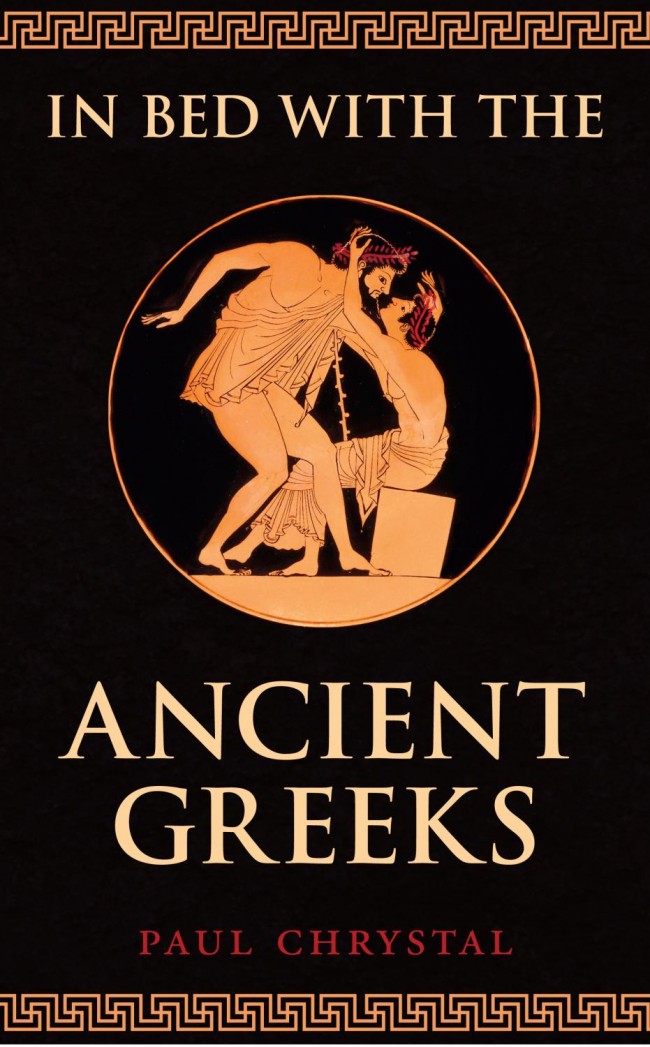
The ‘Greek custom’ has been a euphemism for homosexuality since Roman times. To what extent were the Greeks openly homosexual as we understand it today versus the Greeks not distinguishing sexual desire along gender lines?
‘Greek love’ is sometimes used to refer to anal intercourse, and nowadays even, ‘doing it the Greek way’ still describes anal intercourse. To the Ancient Greeks romantic and sexual relationships between males and between women was indicative of a balanced sex life, having both men and women as lovers; this was considered this quite normal so long as long as one partner was an adult and the other was aged between twelve and fifteen.
To the Ancient Greeks sexual orientation carried little of the stigma it has and can still have in modern societies. There is no vocabulary in Greek or Latin for homosexual or heterosexual which may suggest that the difference did not exercise the Greeks and Romans in anything like the way it has troubled later societies over the last 2,000 years. Indeed, such words as ‘pornography’, ‘homosexual’ and ‘lesbian’ (in its sexual sense) are 19th century in origin.
Greek society, like Roman, was not obsessed with gender-based sexual desire or behaviour, but was rather more concerned with the role that the participants played in the homoerotic sex act – essentially, whether they were an active penetrator or being passively penetrated.
This active-passive model corresponded with dominant and submissive roles in wider society. What was important was not that one practiced sodomy it was how one did it: to sodomise was fine up to a point; there was, however, no excuse for being sodomised.
So reviled was buggery that one of the punishments for adultery with a married woman was to have a raddish shoved up your rectum: ‘raddish reaming’ or ‘radish rape’ – , a symbol of the erect male penis delighting in revenge; another humiliating penalty was singeing off the adulterer’s pubic hair to make the adulterer look effeminate.
The verb is ῥαφανιδόω (rhaphanidoo); if a husband caught his wife and an adulterer in the act, he was at liberty to do whatever he liked to him. Lysias’ On the Murder of Erotosthenes (around 403 BCE) is a defence speech given by a man who killed an adulterer and was accused of various indelicacies at the same time -impiety and entrapment; public humiliation and a court appearance were the usual consequences.
Allowing one’s body to be exploited for pleasure by others in sodomy and oral sex was a sign of weakness, a deficiency of masculinity. It was fine, however, for a man to indulge with males lower down the social ladder, male prostitutes or slaves, so long as he assumed the penetrative role and was in no way passive or submissive. Penetration was manly and powerful; passivity was weak and effeminate: something that women, foreigners and slaves did that was wholly stigmatic and invited prejudice.
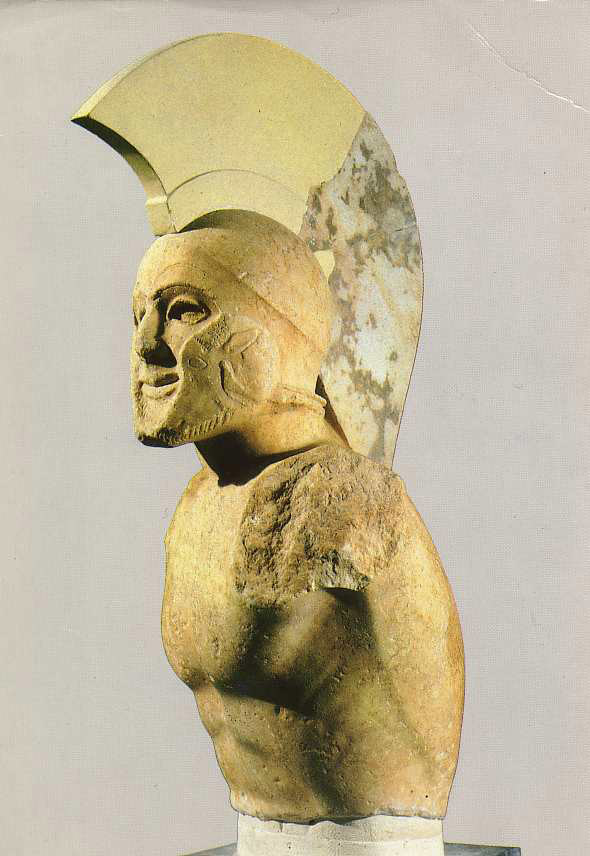
Xenophon wrote Spartans thought it was shameful “to be seen to reach out to touch the body of a boy” while the Athenians employed slaves – pedagogues – to protect their sons from unwanted attention. How tolerant were the Greeks to same-sex relationships and how did this vary over time or by location – and why?
Tolerant, within certain rigid restrictions and conditions. Controversy continues to rage over whether the Spartans practiced pederasty like many of the other poleis. Xenophon says quite categorically that : ‘[Lycurgus] … laid down that in Sparta lovers should refrain from molesting boys, just as much as parents avoid having intercourse with their children or brothers with their sisters’ – thus putting it on a par with incest. Xenophon, though, nails the reason why this statement is seldom believed when he adds: ‘It does not surprise me, however, that some people do not believe this, since in many cities the laws do not ban lusting after boys.’ All of our written sources on Sparta come out of these ‘many cities’ , where pederasty was de riguer amongst the elite – and it was the hostile elite who wrote the histories of Sparta.
Cretan pederasty was an early form of paedophilia dating from the Minoan period, around 1650-1500 BCE, that involved the ritual kidnapping harpagmos of a boy from an elite background by an aristocratic adult male, with the consent of the boy’s father. This male was known as philetor, befriender; the boy was kleinos, glorious.
The man took the boy out into the wilderness, where they spent two months hunting and feasting with friends. If the boy was pleased with how this went he changed his status from kleinos to parastates, or comrade, signifying that he had metaphorically fought in battle alongside his philetor and went back and lived with him. The philetor showers the boy with expensive gifts, including an army uniform, an ox for sacrifice to Zeus, and a drinking goblet – a symbol of spiritual accomplishment. At the same time, according to Strabo, the boy must choose between continuing with or putting an end to the relationship with his abductor, and whether to denounce the man if he has misbehaved in any way.
Were there any other difference in how the various Ancient Greek city states/ cultures approached sex, sexuality and relationships?
Generally speaking any Ancient Greek man was obliged to discharge his important duty as a citizen to replenish and increase the citizenry of his polis, his city state, by having many children, ideally boys.
For a woman, it was vital she had sex with her husband in order to mother as many children as possible, again ideally boys, in order to fulfil her responsibility to provide citizens to populate the army and the state machinery. Doctors, poets and philosophers had all ordained that sex was never a thing of pleasure for the average woman. A survey of Minoan (about 2600 to 1100 BCE) civilisation sexuality reveals the relative freedom there enjoyed by women and girls as relatively full and active members of Cretan society.
Differences in attitudes towards sex and sexuality are exposed in Sparta and later in Macedon (359- 148 BCE) – the one proving relatively liberal and reminiscent of the Minoans, the other using sex and women as political weapons to cement alliances and save dynasties.
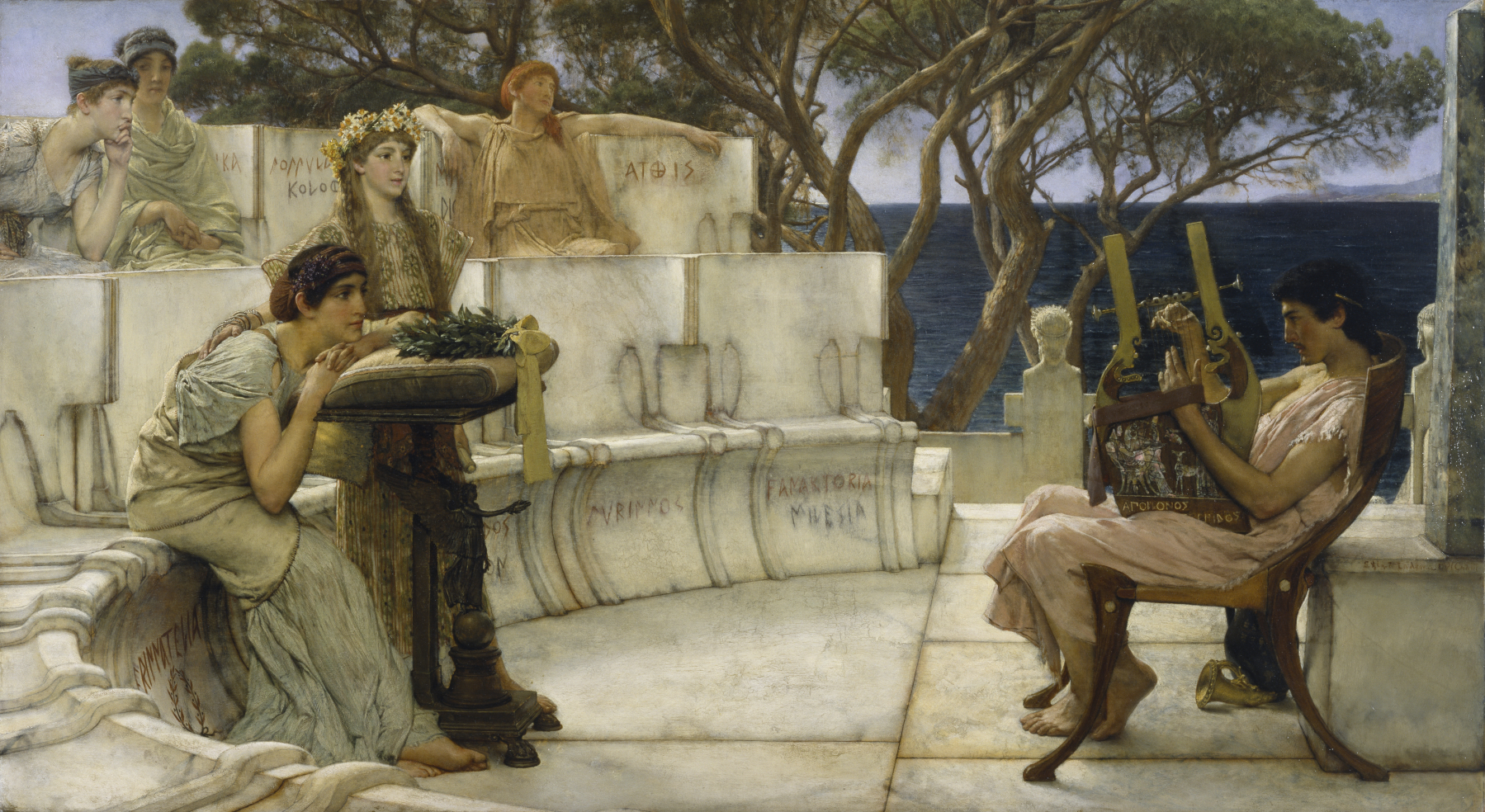
These days Sappho is portrayed as a lesbian icon while the Victorians saw her as the head of a girl’s finishing school, what do we really know about the poet, her ‘thiasos’ and lesbians in Ancient Greece?
Not that much. Sappho (c. 630 – 570 BCE) ran a thiasos – a community in which Greek girls could receive a basic education and, at the same time, were exposed to homosexual love, sometimes for and from their teachers – Sappho herself writes of her love for various students – and sometimes for each other. As the polis evolved, however, marriage as we know it became established as a social norm, bringing an end to the thiasoi and with it much of early Athenian female independence and homosexuality, neither of which had any place within the constraints of this emergent social organisation, the polis.
Despite, critical acclaim from, for example, no less an authority than Plato, it was not too long before Sappho was subjected to male abuse and ridicule. Comedies and satirical biographies predictably portrayed her as stereotypically short, fat and ugly woman who turned to women because she could not attract a man. Others slandered her as a prostitute because homoerotic acts were seen as being the same as whorish acts.
Aristotle is truly surprised that the ‘people of Mytilene honour Sappho’. Why surprised ? Because ‘she is a woman’. Aristotle believed that relative high-standing of women in Spartan society was a major flaw in their political system. In the Politics, he states that Spartan women, despite the fact that they wrestle and do other sports in the gymnasium, were still not trained sufficiently to cope with their freedom, and so turned promiscuous and dissolute, ‘lesbian’, as a result.
When Plato’s Aristophanes describes women who desire other women, words fail him because there is no such word in his language; he uses the term hetairistria with its obvious connotations.
Interestingly, that master of the bawdy joke, Aristophanes, never alludes to female homoerotocism, suggesting perhaps that the subject was too sensitive or potentially offensive to put before the paying Athenian public. On the other hand, he uses the verb lesbiazein to refer to fellatio because the inhabitants of the island of Lesbos allegedly had a predilection for orofacial sex. By the 2nd century CE Lesbos had connotations with female homoerotocism, probably due to the Sappho factor.
Plutarch (46-120 CE) tells us that Spartan noblewomen took young girls as lovers. He says that same-sex erotic relationships between older and younger women were prevalent among Spartans ‘This love was so acceptable to them, that even the beautiful and good women took girls as lovers.’ Plutarch in one line neatly explodes the male stereotype that ‘lesbians’ were all ugly and of ill repute.
From Zeus’ relationships with Ganymede and Leda to the birth of the Minotaur, how significant was sex in Greek mythology?
Very. In the beginning was sex. To the ancient Greek mythologisers sexuality, love and sex were inextricably connected with the creation of the Earth, the heavens, and the Underworld.
Greek myth was a theogony of incest, murder, polygamy and intermarriage in which eroticism and fertility were elemental; they were there right from the start, demonstrating woman’s essential reproductive role in securing the cosmos, extending the human race and ensuring the fecundity of nature.
Simultaneously, Zeus wasted no time in asserting his dominance – not just over the other gods – male and female – but over all things; his cavalier attitude towards female sexuality, as manifested in serial rape and seduction, set the tone for centuries of male domination and female subservience that still prevails today; the depiction of Hera as a distracting, duplicitous and deceptive woman opened the door for years of male mistrust, insecurity and misogyny that still prevails today.
Down on earth, hapless Pandora was doomed soon to open the box and slam the door for ever more on any hope women had for equality or due recognition in the grand scheme of things.
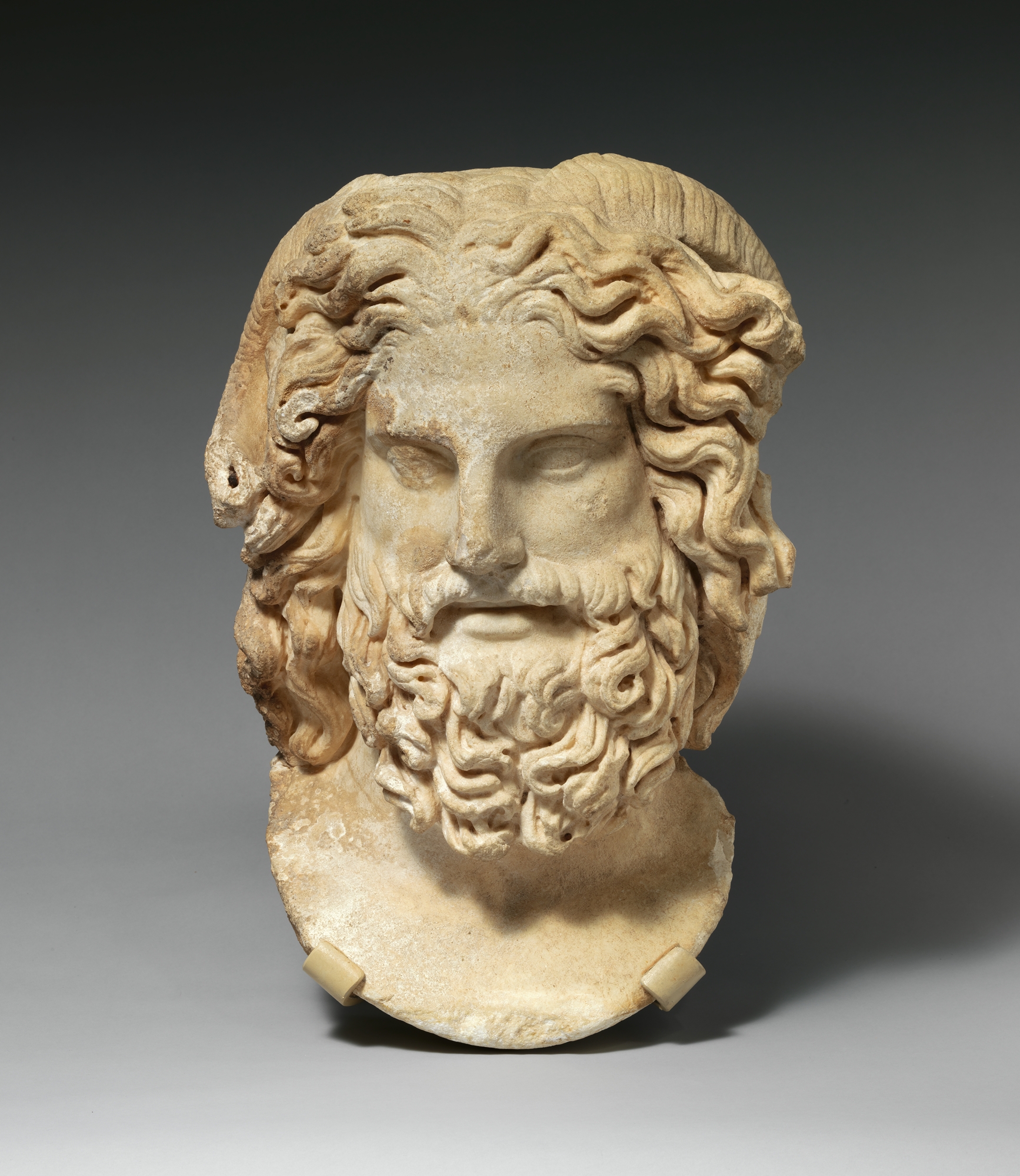
What was ‘erotic magic’ in the context of Ancient Greece, was this a recognised part of mainstream Greek religion or more of a fringe practice as it was in Medieval England?
It was fringe, but it was very popular. The popularity and ubiquity of this evil and sinister form of ancient hate mail is illustrated by the fact that 1,600 or so curse tablets alone – defixiones or katadesies – curse tablets or binding spells – have been found.
Katadesies reach back as far as the fourth century BCE in Greece. Fittingly, they were traditionally consecrated to the gods of the underworld. Mainly a practice of the lower classes, they gave vent to the curser’s vengeful anger , malice and vindictiveness. Around one quarter of the tablets show erotic magic, deployed to wreak bitter revenge on duplicitous lovers, bind an object of desire to love and sex with the dedicator for the rest of his or her days.
Typical is the defixio which rains down every kind of disaster of on the recipient, made all the more exotic with the addition of the usual inexplicable mumbo jumbo:
May burning fever seize all her limbs, kill her soul and her heart; O gods of the underworld, break and smash her bones, choke her, arourarelyoth, let her body be twisted and shattered, phrix, phrox.
Curses were not exclusively heterosexual: one from the 2nd century CE describes a ‘lesbian’ curse where Heraias brings and binds the heart and soul of Sarapias. In another Sophia attempts to inflame the heart, liver and spirit of Gorgonia through a corpse demon in an Egyptian curse. This is edited down from sixty-six lines of torrid text:
By means of the corpse-demon inflame the heart, the liver, the spirit of Gorgonia, whom Nilogenia bore, with love and affection for Sophia, whom Isara bore. Constrain Gorgonia to cast herself into the bath-house for the sake of Sophia; and you, become a bath-room. Burn, set on fire, inflame her soul, heart, liver, spirit with love for Sophia.
Typical is the depravity evident in the sexually perverted, excessively malevolent curse projected at women:
I bind you, Theodotis, daughter of Eus, to the snake’s tail, the crocodile’s mouth, the ram’s horns, the asp’s poison, the cat’s whiskers, the god’s appendage, so that you may never be able to have sex with another man, not be shagged or be buggered or give a blow job , nor do anything that brings you pleasure with another man, unless I alone, Ammonion, the son of Hermitaris, am that man… Make this erotic binding-spell work, so that Theodotis, may no longer be penetrated by a man other than me alone, Ammonion, the son of Hermitaris, dragged in slavery, driven crazy, taking to the air in search of Ammonion, the son of Hermitaris, and that she may rub her thigh on my thigh, her genitals to my genitals, for sex with me for the rest of her life.
The equivalent of Voodoo dolls were another popular, deviant way of cursing the people the Greeks loved to hate; 38 have been found.
The dolls are supported by some sinister instructions, usually to inscribe magical words on her head and other parts of her body, including the genitals; to stick a needle into her brain, and twelve others into other organs; tie a binding spell written on a lead plate to the figures, dedicate it to gods of the underworld and leave it at sunset near to the tomb of someone who has died violently or prematurely; invite them to rise from the dead and bring X [the object of the charm], daughter of Y, to him and make her love him. There then follows a litany of evil instructions to deprive the girl of food and drink, sexual intercourse, sleep and health – all designed to make her have sex with the curser in perpetuity. Dehumanisation , ritual abuse – physical, psychological and sexual, subjugation – were the order of the day. ‘Love’ is very strange indeed.
What religious rites were there specifically about Aphrodite and what role did she play in Greek society?
Aphrodite is seminal, central to Greek life. Aphrodite rose from the foam that was produced in the sea when Uranus’ genitalia fell in there, hence her name, meaning ‘foam-arisen’. Hesiod says that the genitals ‘were carried over the sea for a long time, and white foam arose from the immortal flesh; with it a girl grew’.
That girl, Aphrodite, floated ashore on a scallop shell: this iconic image of Aphrodite as a mature ‘Venus rising from the sea’, Venus Anadyomene, was made famous in a painting by Apelles, now lost, but described for us in the Natural History of Pliny the Elder.
Aphrodite herself provides a Greek word or two: ta aphrodisia is used to denote ‘ pleasures of sex’, and aphrodisiazein, to enjoy having sex.
Aphrodite was the goddess of beauty and sexual love. Aphrodite did not have a childhood; instead she was born a mature woman, a sexually attractive and desirable woman at that; fittingly, she is often depicted nude. Some say Aphrodite was born pregnant with the twins Eros and Himeros, her constant companions and agents of her divine power. In later mythology, she is vain, bad tempered, and petulant. She is a married woman and a serial adulteress.
Aphrodite’s great beauty unsettled the other gods who feared that the rivalry raging over her would lead to war; so Zeus married her off to saturnine Hephaestus, who, because of his ugliness and deformity, would, in theory, diminish the threat she posed. However, Hephaestus achieved the very opposite when he forged her beautiful jewellery, including the cestus, a girdle that made her even more irresistible. Trapped in a loveless marriage, Aphrodite took many lovers—both gods, such as bellicose Ares, and mortals, like Anchises by whom she had Aeneas. In the Odyssey, she is attracted to Ares because of his exciting, volatile nature.
By the late 5th century BC, a distinction was being made between two separate Aphrodites: Aphrodite Ourania, the Aphrodite born from the sea foam, and Aphrodite Pandemos, the common people’s Aphrodite ‘of all the folk’, born from the union of Zeus and Dione. Among the neo-Platonists, Aphrodite Ourania is associated with spiritual love, and Aphrodite Pandemos with physical love. In the Symposium, Plato, through Pausanias, (not the geographer) describes two Aphrodites; Aphrodite Ourania inspires homosexual male love; Aphrodite Pandemos, on the other hand, inspires the love of women for women.
Aphrodite is also known as Areia, to show her relationship with Ares, the god of war, with whom she had an affair. Consequently, she was made into something of a war goddess, notably in Sparta.
What inspired you to write an erotic history of the ancients in the first place and why revisit it?
My In Bed with the Romans has been very well received. There was a need for a lucid, approachable and accessible account of Greek sexuality that was not freighted with the heavy booted academic obfuscation that often attends ‘scholarly’ works. At the same time, there was an obvious need for a well-referenced, but excitingly written work that was not salacious or sensational in any way, a work that would appeal to the interested lover of (ancient) history and gender studies, and to the student of the ancient world.
Paul Crystal in the author of In Bed With the Romans, Women in Ancient Rome and Women ofinAncient Greece. His new book In Bed With the Ancient Greeks is out now from Amberley. For more secrets of the ancient world, subscribe to All About History from as little as £13
